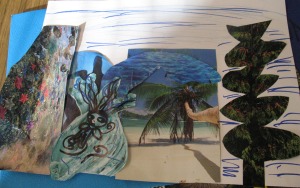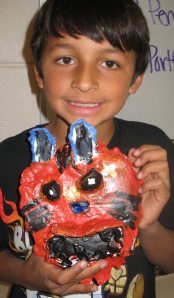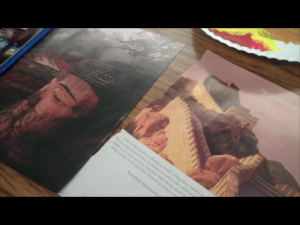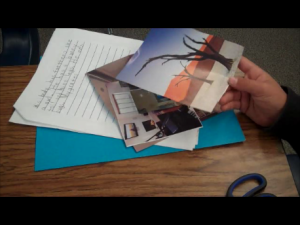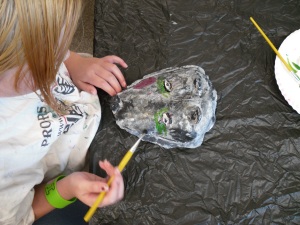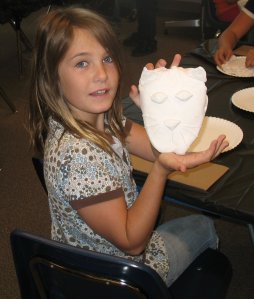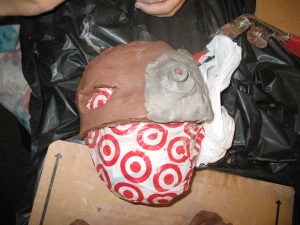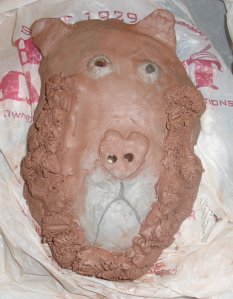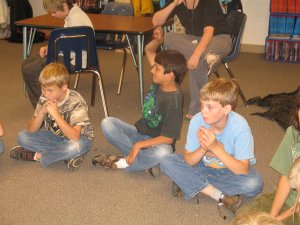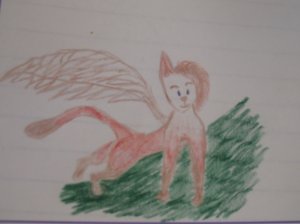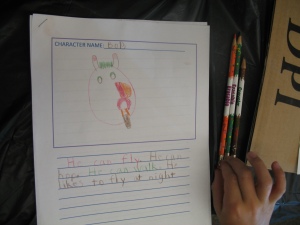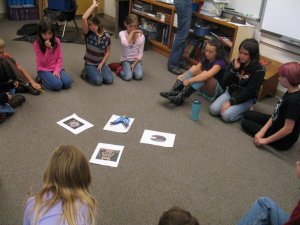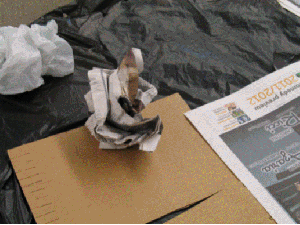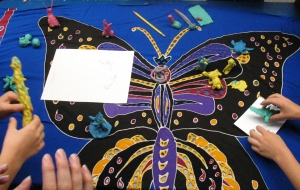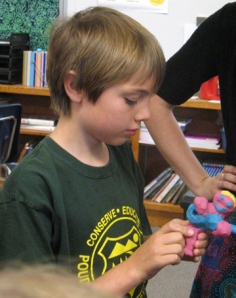- Lesson 1: Ceramic Character Masks
This project was an exploration into character development. Students created clay masks based on characters that were developed during brainstorming activities. The class learned about Native American totem animals and discussed how animals have personal meaning to each individual. Students were shown a variety of masks as examples to further their understanding of how character traits could be represented in the form of a mask. Students learned about the descriptive qualities of texture, shape and color.
The class worked with a wide range of tools to shape and add texture to their masks.They used tools that were both traditional clay tools and non-traditional tools such as kitchen utensils. The masks were then painted with acyclic paint. Students layered colors to achieve texture and depth on the surface of their mask characters.
Within the context of our unit
- Lesson 2: Brainstorming and Collage
This unit began with the students creating a mask character out of clay. Brainstorming sheets were utilized by the students to develop their mask characters further. As you can see the students’ brainstorming styles were as unique as their characters. Some chose to draw, some chose to write, while others felt comfortable doing both.
The next step was to create a collage which enabled the students to envision their mask character’s habitat. Through 2-D, 3-D, and mixed media collages the students created an environment for their mask character. These artworks depicted how it lived, what it ate, and even who its friends might be!
Both of these projects helped the students to develop their understanding of story building concepts such as character development and setting
- Lesson 3: Community Islands
The Community Island project explored cooperative work. Each individual character that was created during our Storytelling Unit is represented in a cluster of islands. In order to combine ideas and worlds, the students had to work collaboratively. Space, form, and surface were all concepts the class explored through the construction of their islands, using mixed media and assemblage.
The students were enthusiastic to work with one another. They embraced the opportunity to create symbiotic relationships between their characters in an environment that can host multiple creatures. They were free to be innovative and apply critical thinking to their work. Considering how the scene would change in order to accommodate for different personalities and behaviors provided a unique challenge. The scientific concepts of habitat and symbiosis were solidified in their expressive examination. This project also incorporated the involvement of character relationships and story development.
Chart
How the standards were met in LESSON 1: During this lesson the students were first asked to write and draw about their mask character. After substantial brainstorming the students then proceeded to create a mask character in clay.
- Comprehend: Visual arts connect multiple characteristics of art. The students were able to recognize how mask are used to develop character. The students recognize that their masks can represent both physical attributes and psychological traits.
- Create: Materials and processes can be used in traditional, unique, and inventive ways. The students were able to create their character masks from clay. In the process of creating their masks they learned to use different sculpting techniques utilizing conventional and unconventional carving and texturizing tools.
- Transfer: Artists, viewers, and patrons respond to art from familiar and unfamiliar cultures. We discussed Native American totem animals with the class. It was explained that in this culture animals represent different personality attributes. For instance, the Wolf represents loyalty, perseverance, success, and intuition.
How the standards were met in LESSON 2: During this lesson the students asked to envision the environment in which their mask character lived. They were then given the instruction to create a collage to represent this habitat.
- Create: Visual arts communicate the human experience. The students were able to describe how a collage can tell a story about their mask character. Their collage depicted how and where their mask characters lived. The students continued their story building
- Create: Applying an understanding of art processes and creative thinking to plan and create art. The students’ brainstorming sheets contained information about their masks characters, so the students used them to plan out their collages.
How the standards were met in LESSON 3: During this lesson the students were asked to work collaboratively in order to create a 3-dimensional habitat shared by their mask characters.
- Comprehend: Visual arts learning involves analyzing the formal and sensory qualities of art. Images were shown and discussed that illustrated how textures can be represented in art.
- Reflect: Specific methods of planning support the development of intended meaning. The students were shown a video about symbiosis. This enabled them to understand the importance of working together and develop ways in which they could accomplish this.
- Create: Materials and processes can be used in traditional, unique, and inventive ways. The students demonstrated this by combining elements of their 2-D collages with their 3-D collaborative projects. The also created their construction using a variety of media (mixed media assemblage: paint, construction paper, drawing, markers, cardboard and found objects.)
Process
The students explored many materials and processes this semester. They worked with clay, paint, construction paper, found objects, and cardboard. During our storytelling unit students demonstrated many important skills such as: self-direction, collaboration, and creative problem solving.
During the mask project the students strengthened their literacy skills through the brainstorming activities. The class developed lists of characteristics for their masks, they wrote elaborate stories about their characters, and discussed their work during video interviews. Through working with clay students developed an understanding of sequencing. Students learned that clay has to be fired before it can be painted. They also discovered some of the limitations of clay. As students were creating their masks, the clay would sometimes sag or crack. Students used their problem solving skills to build supports for their masks.
During the collage project students demonstrated self-direction and teamwork. The class spent one morning searching through magazines for images to include in their collages. While searching for their own images many students worked together to help others find what they needed. Students were continuing to develop their understanding of sequencing through the collage project. Their collages were an important step between the mask characters they had already created and the habitats that they were about to start creating.
The community island project taught the class about collaboration, and creative problem solving. By working together in small groups students had to develop techniques to construct a three dimensional habitat. Students worked with hot glue, cardboard, fabric, glitter, paint, pipe cleaners and many other found materials. Some materials presented challenges that students were able to work through together.
Art Show
The artwork displayed in the art show was truly a testament to how hard all of the Lab School students worked!! Observing all of the projects each class did was both exciting and awe-inspiring on both the teacher and student perspective. Stepping into the exhibition space was exciting and overwhelming. Art seemed to cover every last foot of that space! The students were able to look at artwork from their friends, from other grade levels, and also had the opportunity to see their own work in a new light than they had the past couple of weeks!
The artwork displayed from one grade level to the next was very telling about how lessons had to be structured and how units evolved over time. The 4th and 5th grade classes in particular was very interesting to observe- as the units were very similar but were approached in different ways. No two art pieces looked the same, which holds great hope to the innovation and level of creativity these students have!
The activity for the Art Exhibit intended to:
- Recognize, articulate, and debate that the visual arts are means for expression
- Use specific criteria to discuss and evaluate works of art
- Critique personal work and work of others with informed criteria
This included discussing what kind of story a certain piece of artwork may be telling, as well as comparing two pieces of artwork in their similarities and differences.
While the exhibition was a lot of visual information to take in, the students commented on how much time and effort it took to produce so much art. It was really astonishing to see what we had accomplished in a small amount of time!
One detail we had picked up on the experience with the art show was the importance of “art language”. The right vocabulary is a tool that assists on approaching works of art aside from what the artist creates. Realizing texture, color, form and shape beyond what is “seen” will help these conversations along.















